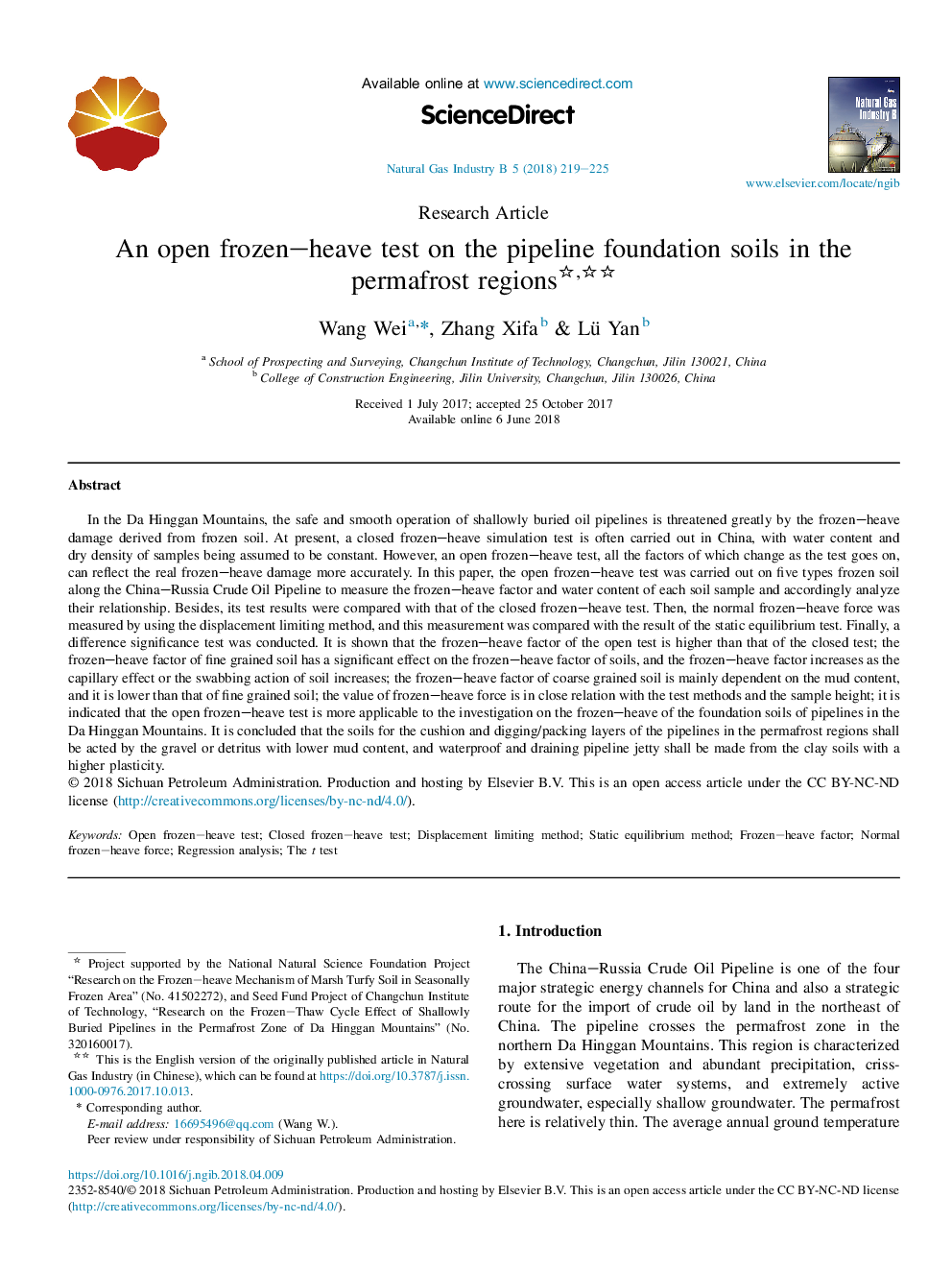| کد مقاله | کد نشریه | سال انتشار | مقاله انگلیسی | نسخه تمام متن |
|---|---|---|---|---|
| 8109485 | 1522254 | 2018 | 7 صفحه PDF | دانلود رایگان |
عنوان انگلیسی مقاله ISI
An open frozen-heave test on the pipeline foundation soils in the permafrost regions
ترجمه فارسی عنوان
آزمایشی باز یخ زده در زمین های پایه خط لوله در مناطق مرجانی مریخ
دانلود مقاله + سفارش ترجمه
دانلود مقاله ISI انگلیسی
رایگان برای ایرانیان
کلمات کلیدی
ترجمه چکیده
در کوههای دا هینگگان، عملیات ایمن و صحیح از خطوط لوله نفتی کم عمق، به شدت تحت تأثیر آسیب یخ زده از خاک یخ زده تهدید می شود. در حال حاضر، یک آزمایش شبیه سازی بسته یخ زده، اغلب در چین انجام می شود، با توجه به اینکه میزان آب و چگالی خشک نمونه ها ثابت است. با این حال، آزمون باز یخ زده، تمام عواملی که تغییر می دهند به عنوان آزمون ادامه می دهد، می تواند آسیب واقعی یخ زده را دقیق تر نشان دهد. در این مقاله آزمون آزمایشی یخ زده باز بر روی پنج نوع خاک یخ زده در طول خط لوله نفت خام چین و روسیه برای اندازه گیری فاکتور یخ زده و میزان آب در هر نمونه خاک انجام شده است و بر اساس آن، رابطه آنها را تحلیل می کند. علاوه بر این، نتایج آزمون آن با آزمون آزمایش انجماد بسته مقایسه شد. سپس نیروی یخ زده معمولی با استفاده از روش محدود کردن جابجایی اندازه گیری شد و این اندازه گیری با نتیجه آزمون تعادل استات مقایسه شد. در نهایت، آزمون معنی داری تفاوت انجام شد. نشان داده شده است که عامل فشرده یخ زده از آزمون باز بالاتر از آزمون بسته است. فاکتور یخ ریختگی خاک خاک ریز دارای تأثیر قابل توجهی بر فاکتور یخ زدگی خاک می باشد و عامل فشرده یخ زده به عنوان اثر مویرگی یا اثر سواببرای خاک افزایش می یابد؛ فاکتور یخ ریختگی خاک خشتی عمدتا وابسته به محتوای گل است و کمتر از خاک خشخاش است. مقدار نیروی یخ زده در ارتباط نزدیک با روش های آزمون و ارتفاع نمونه است؛ نشان داده شده است که آزمایش باز یخ ریختگی بیشتر برای تحقیقات بر روی انجماد خاک پایه خطوط لوله در کوه های دا هینگگان قابل استفاده است. به این نتیجه می رسیم که خاک برای بسته بندی و بسته بندی لایه های خطوط لوله در مناطق مرجانی مریخ باید توسط ماسه و یا خرده چوب با محتوای گل و لای پایین عمل می کند و از آبهای سطحی و مخزن تخلیه از خاک خاک رس با بالاتر پلاستیک
موضوعات مرتبط
مهندسی و علوم پایه
مهندسی انرژی
مهندسی انرژی و فناوری های برق
چکیده انگلیسی
In the Da Hinggan Mountains, the safe and smooth operation of shallowly buried oil pipelines is threatened greatly by the frozen-heave damage derived from frozen soil. At present, a closed frozen-heave simulation test is often carried out in China, with water content and dry density of samples being assumed to be constant. However, an open frozen-heave test, all the factors of which change as the test goes on, can reflect the real frozen-heave damage more accurately. In this paper, the open frozen-heave test was carried out on five types frozen soil along the China-Russia Crude Oil Pipeline to measure the frozen-heave factor and water content of each soil sample and accordingly analyze their relationship. Besides, its test results were compared with that of the closed frozen-heave test. Then, the normal frozen-heave force was measured by using the displacement limiting method, and this measurement was compared with the result of the static equilibrium test. Finally, a difference significance test was conducted. It is shown that the frozen-heave factor of the open test is higher than that of the closed test; the frozen-heave factor of fine grained soil has a significant effect on the frozen-heave factor of soils, and the frozen-heave factor increases as the capillary effect or the swabbing action of soil increases; the frozen-heave factor of coarse grained soil is mainly dependent on the mud content, and it is lower than that of fine grained soil; the value of frozen-heave force is in close relation with the test methods and the sample height; it is indicated that the open frozen-heave test is more applicable to the investigation on the frozen-heave of the foundation soils of pipelines in the Da Hinggan Mountains. It is concluded that the soils for the cushion and digging/packing layers of the pipelines in the permafrost regions shall be acted by the gravel or detritus with lower mud content, and waterproof and draining pipeline jetty shall be made from the clay soils with a higher plasticity.
ناشر
Database: Elsevier - ScienceDirect (ساینس دایرکت)
Journal: Natural Gas Industry B - Volume 5, Issue 3, June 2018, Pages 219-225
Journal: Natural Gas Industry B - Volume 5, Issue 3, June 2018, Pages 219-225
نویسندگان
Wei Wang, Xifa Zhang, Yan Lü,
